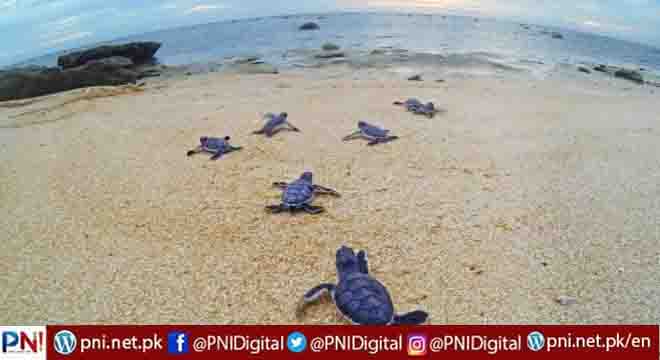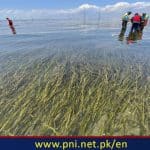Doha, July 9 (AFP/APP): On a beach in northeastern Qatar, six-year-old Lolwa waves goodbye to two baby hawksbill turtles — a species that has a one in a thousand chance of surviving to adulthood.
Predators, climate change, fishing nets and marine pollution all contributed to the classification of these narrow-beaked creatures as “critically endangered” in 1996.
But a conservation programme in Qatar is hoping to revive the dwindling species, releasing thousands of hatchlings into the sea each year, now with the help of young children.
“As adults we are kind of beyond hope,” said Clara Lim, a representative of the Dadu children’s museum that organised the initiative for youngsters.
“But children have the power to really internalise all these things that they are learning… and they make these habits part of their life.”
The Qatari programme was launched as far back as 2003, and in the last five years has sent some 30,000 hatchlings into the sea, including 9,000 in 2020 when the pandemic cleared the waters of their human visitors.
Between April and June, Qatari environmentalists watch for female hawksbills that have arrived at Fuwairit beach to give birth, measuring them, providing care if needed, and sometimes attaching tracking devices.
The nests are moved from under the sand on the main beach and placed under an awning to protect them from tides and predators.
Sixty days later, at the time of hatching, “the good and healthy ones… we release to the sea,” said Mohamed Seyd Ahmed, a wildlife expert at the Qatari environment ministry.
“Other small or tired ones… we release in a pool” to allow them to grow stronger first, he added.
The turtles “act as a vacuum (cleaner)”, Ahmed explained, consuming jellyfish and seagrass, so their decline has an effect “on all marine life”.
– Confronting threats –
On an evening in June, young Lolwa is joined by eight-year-old Shaikha and nine-year-old Abdullah to release the baby turtles out to sea.
Close contact with the turtles has created a bond between them and the children, who have affectionately given the creatures names like Sassa and Blueberry.
As hoped, attitudes are already changing in this young generation.
“We cannot throw plastic in the sea because they (the turtles) will get caught in the plastic,” says Shaikha.
Poaching and a lack of space also threaten these animals that reach adulthood at 25 and live for an average of 50 years.
Since turtles instinctively return to lay eggs on the beaches where they were born, it will be possible to measure the success of the programme, but not until 2028, when the first hatchlings released in 2003 come back to lay their eggs.
But with 97 nests — each containing between 80 and 120 eggs — on Fuwairit beach this year compared to 15 in 2012, there is already cause for optimism.
“The statistics show that there are more turtles coming to breed here,” says Thierry Lesales, president of the Qatar Natural History Group.
Follow the PNI Facebook page for the latest news and updates.








